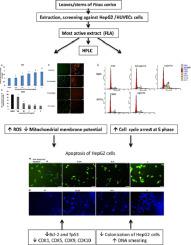South African Journal of Botany ( IF 2.7 ) Pub Date : 2021-01-13 , DOI: 10.1016/j.sajb.2020.12.018 Kiren Mustafa , Shaoxuan Yu , Wen Zhang , Hassan Mohamed , Tahira Naz , Haifang Xiao , Yingxin Liu , Yusuf Nazir , Abu Bakr Ahmad Fazili , Shaista Nosheen , Xueyuan Bai , Yuanda Song

|
Liver cancer is one of the most frequent causes of cancer-related deaths worldwide. The current study sought to screen, for the first time, a Ficus carica variety from the Shandong province of China against hepatocellular (HepG2) cells. Crude extracts of F. carica with various polarities were prepared and screened against HepG2 cells. The acetone extract of the leaf (FLA) exhibited significant antiproliferative effects against HepG2 cells (IC50 = 0.179 mg/mL) while producing the least toxicity on normal human umbilical vein endothelial cells (HUVECs). Biochemical evidence of apoptosis was confirmed by staining with DAPI and AO/EB. FLA also exhibited moderate anti-colonization potential against the population of HepG2 cells. It selectively arrested the cell cycle of HepG2 cells at the S phase and exerted anticancer activity by significantly increasing the reactive oxygen species (1.59 fold) inside the cells, which subsequently resulted in loss of the mitochondrial membrane potential as revealed by JC-1 probe assay. FLA downregulated the expression of tumor-promoter Transcription Factor (TP53), anti-apoptotic proteins (Bcl-2), and cell cycle regulatory kinases (CDK1, 5, 9) with respect to untreated cells for 24 h, 48 h, and 72 h. High-performance liquid chromatography (HPLC) of FLA revealed the presence of gallic acid and quercetin as major antiproliferative compounds along with trace amounts of rutin, luteolin, apigenin, benzoic acid, and β-sitosterol. Notably, our study showed FLA operating via novel mechanisms involving reactive oxygen species (ROS) generation and CDKs involvement in HepG2 cells. Thus, it suggests that FLA may be a potential source of new drugs in the treatment of liver cancer.











































 京公网安备 11010802027423号
京公网安备 11010802027423号